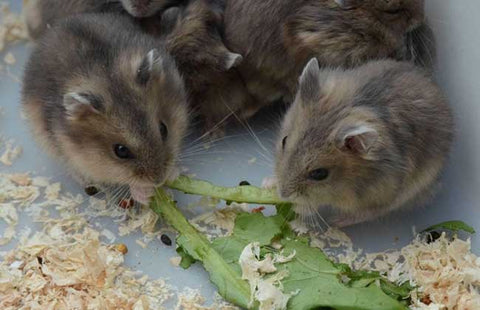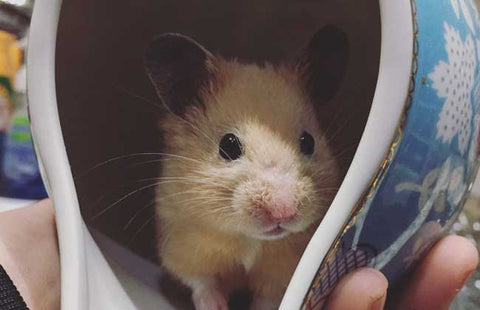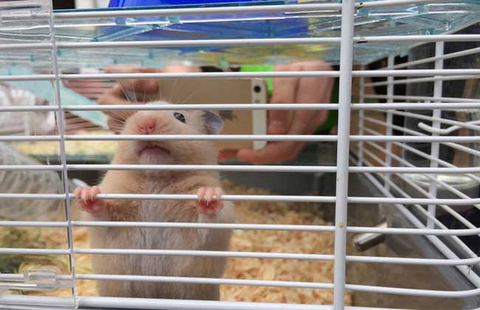The hamster is a solitary animal, and it is also a very popular pet. It is usually 5-12 cm in length, and its body is relatively fat. Except for the small hamster distributed in Central Asia, other types of hamsters have cheek pouches and get their names. Common species include golden bears, three-line hamsters, first-line hamsters, etc. Let's take a look at how to keep hamsters and can live longer. And every type of hamster has a different lifespan, click this link to learn more.
Hamster Feeding Equipment
1. Cage: Now there are special cages for hamster breeding on the market. You can choose a wire cage or a wooden hamster cage. But I recommend the latter, especially some wooden cages made of natural wood, which are very healthy and without a strong smell.
Small animal habitats and cages can provide a great place for all living things and small animals to frolic. It is the best choice for you if you are keeping small animals right now because it offers heaven for your pets and prevent them from missing. This small animal hutch indoor is a genuine villa for your most-loved pets.
Sometimes hamsters will grab the wire to climb up, so there is a danger of falling, so the cage should not be very high, and the bottom of the cage should be covered with wheat straw, hay, sawdust Newspaper strips, etc.
2. Food bowl: There is usually a food bowl in the cage. The food bowl should not be easily overturned and the edge should not be too high, otherwise, the hamster will have difficulty eating. Of course, it can also be replaced with some household items, such as glass ashtray, bowl, etc.

3. Drinking water: The drinking fountain and the food bowl are generally self-contained. When purchasing, pay attention to testing whether there is water leakage.
Of course, you can also find a small container instead, but do not use the bowl directly, because hamsters are easy to get wet and catch a cold.
4. Toilet: The toilet is relatively simple. Just get a plastic box and put cat litter on it, but you need to take out the agglomerated cat litter or replace it every day because hamsters also prefer to be clean.
5. Bathing: Hamsters like to bathe in the cat litter in the toilet, but this is not very hygienic. You can make a special bathroom and then put the bath sand.
Of course, the bath sand needs to be disinfected in advance. The disinfection method is to wash it and dry it in Microwave.

6. Bedding material: Hamsters generally use wood chips as the bedding material for the hamster cage. Because it is relatively clean and easy to obtain, some people will use paper bedding material.
At this time, we should pay attention to it. Never use printed paper because the ink may cause poisoning in hamsters.
What Do Hamsters Eat?
1. Vegetables: greens, carrots, spinach, cucumber, cabbage, squash, etc.
2. Seeds: sunflower seeds, peanuts, walnuts, pine nuts, etc.
3. Fruits: apples, strawberries, cherries, etc.
4. Grains: chicken feed, bird feed, wheat, corn, millet, etc.
5. Plants: dandelion, kudzu, plantain, etc.
6. Animals: beef, chicken, milk, yogurt, mealworms, barley worms, etc.
Hamster Health Check
1. Teeth: The incisors of hamsters are constantly growing. Sometimes the teeth are too long and they can't eat. You can use small animal tooth-cutting tools to cut them. If you don't dare to cut your teeth, you can take them to the animal doctor to cut.
2. Fragrance glands: When male rats are in estrus, sometimes the scent glands will accumulate too much. Remember to use hydrogen peroxide to adjust the saline solution and wipe them with a 1:10 mixture.
3. Eyes: If the hamster is healthy, the eyes should be very bright and shiny. If it is red, oily, or has eye mucus, pay attention and take it to the doctor.

4. Poop: A hamster's poop should be a little firm, the size of a grain of rice, black and odorless. If the stool is soft or smelly, it should be taken to the veterinary hospital for cleaning by a doctor.
5. Cheek pouch: The hamster should regularly pay attention to whether the cheek pouch has the odor of food spoilage, and regularly remove the food in the cheek pouch. Use saline to adjust the water and use a feeding syringe to extend into the cheek pouch at a ratio of 1:3. rinse.
6. Coat color: The hamster's hair is usually soft and shiny. If there is hair loss, please observe it to see if it is allergic, and bring it to the animal doctor to check it as soon as possible.
7. Body temperature: The body temperature of a hamster is slightly higher than that of a human when touched by hand, but it is not obvious. If you feel that the body temperature of the hamster is too high, please send it to the hospital immediately. It is very likely to be a precursor to heat stroke.
Precautions for Hamsters
1. Do not feed the food that people eat. Too high salt or too heavy seasoning will increase the burden on the hamster.
2. Do not let them directly touch the sun. Hamsters are very afraid of heat. When summer is coming, please use heat sinks or marbles to cool them off.
3. Do not use unidentified feed, please discard the worms or mold, and do not feed!
4. Do not let hamsters drink raw water, please let them drink boiled cold water.
5. Do not use bamboo chopsticks, popsicles, and other things to make hamsters grind their teeth. Please use the special teeth grinding supplies and feed for hamsters on the market.
6. Do not use newspapers, facial paper, etc. as bedding materials. There is too much ink in the newspapers, and the facial paper contains bleach.
7. Do not keep hamsters in a space that is too small. The space must at least have rollers, water bottles, food bowls, small nests, and other supplies.

